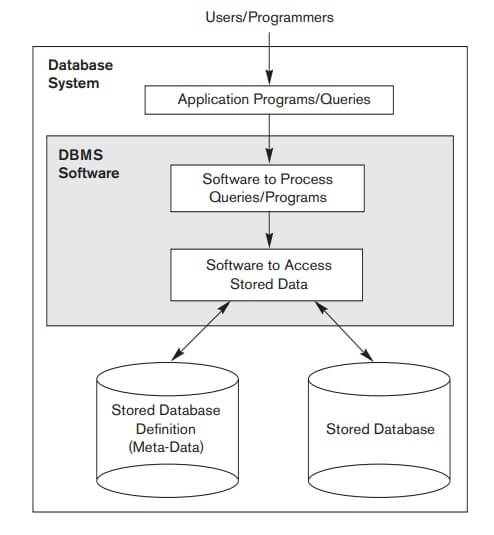Let us consider a simple example that most readers may be familiar with: a UNIVERSITY database for maintaining information concerning students, courses, and grades in a university environment. Figure shows the database structure and a few sample data for such a database. The database is organized as five files, each of which stores data records of the same type. The STUDENT file stores data on each student, the COURSE file stores data on each course, the SECTION file stores data on each section of a course, the GRADE_REPORT file stores the grades that students receive in the various sections they have completed, and the PREREQUISITE file stores the prerequisites of each course.
To define this database, we must specify the structure of the records of each file by specifying the different types of data elements to be stored in each record. In Figure, each STUDENT record includes data to represent the student’s Name, Student_number, Class (such as freshman or ‘1’, sophomore or ‘2’, and so forth), and Major (such as mathematics or ‘MATH’ and computer science or ‘CS’); each COURSE record includes data to represent the Course_name, Course_number, Credit_hours, and Department (the department that offers the course); and so on. We must also specify a data type for each data element within a record. For example, we can specify that Name of STUDENT is a string of alphabetic characters, Student_number of STUDENT is an integer, and Grade of GRADE_REPORT is a single character from the set {‘A’,‘B’,‘C’,‘D’,‘F’,‘I’}. We may also use a coding scheme to represent the values of a data item. For example, in Figure we represent the Class of a STUDENT as 1 for freshman, 2 for sophomore, 3 for junior, 4 for senior, and 5 for graduate student.
To construct the UNIVERSITY database, we store data to represent each student, course, section, grade report, and prerequisite as a record in the appropriate file. Notice that records in the various files may be related. For example, the record for Smith in the STUDENT file is related to two records in the GRADE_REPORT file that specify Smith’s grades in two sections.
Similarly, each record in the PREREQUISITE file relates two course records: one representing the course and the other representing the prerequisite. Most medium-size and large databases include many types of records and have many relationships among the records.
STUDENT
| Name | Stdent_number | Class | Major |
| Smith | 17 | 1 | CS |
| Brown | 8 | 2 | CS |
COURSE
| Course_name | Course_number | Credit_hours | Department |
| Intro to Computer Science | CS1310 | 4 | CS |
| Data Structures | CS3320 | 4 | CS |
| Discrete Mathematics | MATH2410 | 3 | MATH |
| Database | CS3380 | 3 | CS |
SECTION
| Section_identifier | Courde_number | Semester | Year | Instructor |
| 85 | MATH2410 | Fall | 07 | King |
| 92 | CS1310 | Fall | 07 | Anderson |
| 102 | CS3320 | Spring | 08 | Knuth |
| 112 | MATH2410 | Fall | 08 | Chang |
| 119 | CS1310 | Fall | 08 | Anderson |
| 135 | CS3380 | Fall | 08 | Stone |
GRADE_REPORT
| Student_number | Section_identifier | Grade |
| 17 | 112 | B |
| 17 | 119 | C |
| 8 | 85 | A |
| 8 | 92 | A |
| 8 | 102 | B |
| 8 | 135 | A |
PREREQUISITE
| Course_number | Prerequisite_number |
| CS3380 | CS3320 |
| CS3380 | MATH2410 |
| CS3320 | CS1310 |
Database manipulation involves querying and updating. Examples of queries are as follows:
- Retrieve the transcript a list of all courses and grades of ‘Smith’
- List the names of students who took the section of the ‘Database’ course offered in fall 2008 and their grades in that section
- List the prerequisites of the ‘Database’ course
Examples of updates include the following:
- Change the class of ‘Smith’ to sophomore
- Create a new section for the ‘Database’ course for this semester
- Enter a grade of ‘A’ for ‘Smith’ in the ‘Database’ section of last semester
These informal queries and updates must be specified precisely in the query language of the DBMS before they can be processed.
At this stage, it is useful to describe the database as a part of a larger undertaking known as an information system within any organization. The Information Technology (IT) department within a company designs and maintains an information system consisting of various computers, storage systems, application software, and databases. Design of a new application for an existing database or design of a brand new database starts off with a phase called requirements specification and analysis.
These requirements are documented in detail and transformed into a conceptual design that can be represented and manipulated using some computerized tools so that it can be easily maintained, modified, and transformed into a database implementation. (We will introduce a model called the Entity-Relationship model in that is used for this purpose.)
The design is then translated to a logical design that can be expressed in a data model implemented in a commercial DBMS. (In this book we will emphasize a data model known as the Relational Data Model from before chapter onward. This is currently the most popular approach for designing and implementing databases using relational DBMSs.) The final stage is
physical design, during which further specifications are provided for storing and accessing the database. The database design is implemented, populated with actual data, and continuously maintained to reflect the state of the miniworld.
| Read More Topics |
| Microprocessor based controller |
| Object oriented testing |
| Introduction to Database |






